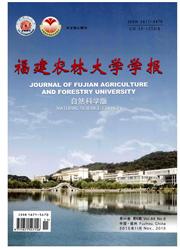

 中文摘要:
中文摘要:
为了研究环境温度对蜂巢内温湿度的影响,设计了一种在蜂群处于近乎原生态环境下的温湿度测试系统.该系统根据巢脾位置前后对称和蜂房均匀分布情况,在巢脾间隙处精确地放置微型温湿度传感器.上位计算机和下位单片机通信采用无线方式.计算机控制单片机何时采集,单片机采集的温湿度值传给计算机并显示和存储在计算机上.通过对检测数据的分析可知:在环境温度较高时,蜂巢各点温湿度几乎相等,蜜蜂均匀分布在蜂巢中:在环境温度较低时,从中间巢脾向最外层巢脾温度递减湿度递增,对于单张巢脾,从巢脾几何中心区域向周边区域温度递减湿度递增,说明蜜蜂聚集在蜂巢中间.无论环境温度高低,在蜜蜂分布区域都呈现出恒温和恒湿现象,蜂巢中心温度和湿度分别是(35±1)℃和(56±10)%RH.
 英文摘要:
英文摘要:
To study the effect of environmental temperature on internal temperature and humidity of beehive, a test system comprising of miniature temperature and humidity sensors locating in the gaps between honeycombs was applied to measure the temperature and humidity of beehive in an undisturbed ecological status. The system was based on the principles of symmetric distribution of honeycomb in hive and homogeneous distribution of honeycomb cells. Microcontrollers were regulated by a host computer in data collection, displaying and saving on the computer in wireless way. Results showed that the temperature and humidity of brood cells of honeycombs were almost homogeneous when the ambient temperature was high, and under such circumstance bees were evenly distributed in the hive. However, when the ambient temperature was lower, internal temperature dropped and humidity increased from the center to the outermost layer of comb. The same pattern was applied to a single comb that temperature declined and humidity increased from the geometric center to periphery of honeycomb, indicating that bees gathered in the middle of the hive. In conclusion, regardless of varying external temperature, temperature and humidity of beehive section where bees occupied stayed constant at (35 ±1) ℃, and the relative humidity was (56±10)%.
 同期刊论文项目
同期刊论文项目
 同项目期刊论文
同项目期刊论文
 期刊信息
期刊信息
